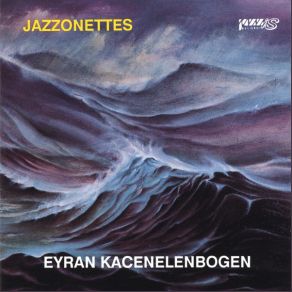Jazzonettes
Download links and information about Jazzonettes by Eyran Kacenelenbogen. This album was released in 1991 and it belongs to New Age genres. It contains 11 tracks with total duration of 01:08:33 minutes.

|
|
|---|---|
| Artist: | Eyran Kacenelenbogen |
| Release date: | 1991 |
| Genre: | New Age |
| Tracks: | 11 |
| Duration: | 01:08:33 |
| Buy it NOW at: | |
| Buy on iTunes $9.99 | |
Tracks
[Edit]| No. | Title | Length |
|---|---|---|
| 1. | Piano Improvisation # 1 (Kacenelenbogen) | 6:10 |
| 2. | Piano Improvisation # 2 (Kacenelenbogen) | 4:39 |
| 3. | Piano Improvisation # 3 (Kacenelenbogen) | 7:04 |
| 4. | Piano Improvisation # 4 (Kacenelenbogen) | 7:38 |
| 5. | Piano Improvisation # 5 (Kacenelenbogen) | 5:25 |
| 6. | Piano Improvisation # 6 (Kacenelenbogen) | 7:23 |
| 7. | Piano Improvisation # 7 (Kacenelenbogen) | 3:47 |
| 8. | Piano Improvisation # 8 (Kacenelenbogen) | 9:45 |
| 9. | Who Can I Turn To (Bricusse - Newley) | 4:14 |
| 10. | Piano Improvisation # 9 (Kacenelenbogen) | 8:47 |
| 11. | When You Wish Upon A Star (Harline-Washington) | 3:41 |
Details
[Edit]This 1989 recording was made while pianist Eyran Katsenelenbogen, then just 25, was still living in his native Israel. Since then he has moved to the United States where, among other things, he holds down a faculty position at the New England Conservatory of Music. In addition, he has changed the spelling of his last name from Kacenelenbogen to Katsenelenbogen. This album reveals the pianist's strong classical education, as it sets forth a variety of improvisational ideas in sonata form. They run the gamut of tempi, from the slow wispy musings of "Piano Improvisation No. 1" to the lively allegro of "Piano Improvisation No. 3." Listening closely to the latter, one hears jazz syncopations much in the way that George Gershwin incorporated them in his classical endeavors. The pianist uses "Piano Improvisation No. 8" to display dazzling virtuosity. The heaviness of this piece is out of character with the rest of the CD. "Piano Improvisation No. 9" is the culmination of the musical plan envisioned by this series of solo pieces. Here, the pianist is meditative and introspective, but without any loss of strength or assurance. The two standards on the CD, "Who Can I Turn To" and "When You Wish Upon a Star," take on the harmonic trappings of the classical-like improvisational pieces. It is the latter piece that is the most intriguing. Playing the melody single note by single note high on the keyboard with his right hand, Katsenelenbogen captures the full essence of hopeful yearning that this lovely tune embodies. This CD is a sterling exhibition of the art of the piano solo, and is recommended.